
Deciding to host a virtual conference or summit – also referred to as an online conference – often seems like a a natural move for expertise-based businesses that already host face-to-face events or that are looking for new approaches to online education and events.
As I’ve already argued, they can be a great business model. (And that was true before Covid.)
If you or your organization already offer a face-to-face conference, hosting a virtual conference can be be a natural way to reach even more people.
If you don’t currently offer any sort of conference, launching a virtual conference can be a great way to expand your portfolio of offerings, attract new customers, and generate new revenue.
But there’s a catch.
You can’t just string together a bunch of Webinars and expect to have a successful virtual conference.
If you want to attract attendees, keep them coming back time after time, and grow your virtual conference into a valuable asset for your business, you need to put the right technology in place and take some basic steps to get the most out of the medium.
Fortunately, I’ve been through the process of launching, host, and growing multiple virtual conferences and summits – Learning • Technology • Design™ (LTD) and Live Review, for example – and have learned more than a few lessons with sharing. In this post, I offer tips for hosting a successful online conference based off of my own experience as well as experience working with a long list of clients that host virtual conferences.
So, let’s get started.
1. Add strong context to your content
It’s relatively easy to round up a bunch of different presenters, schedule them for Webinars over a couple of days, and call that a virtual conference. The problem with this approach is that the sessions are usually only loosely related, attendees tend to cherry pick, and in the end, very little real learning happens.
If you want to deliver real value and impact when you host a virtual conference – and, as a result, prime your attendees to return for your next offerings – you need to put effort into “curating” the experience in way that helps bring out the value of the content in much the same way that a well-curated exhibit in a museum greatly enhances the value of the objects on display.
For our Learning • Technology • Design™ (LTD) virtual conference, this meant have an overarching theme or “big idea” that drove the event – in our case, that learning is a business, and that excelling as a learning business professional requires a commitment to continuous growth in the areas we have identified in our Learning Business Maturity Model.
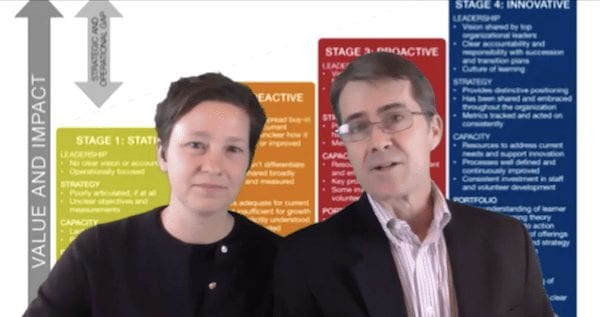
To introduce and sustain this theme – and to highlight connections among the sessions and the theme – we hosted an opening “priming” session and a closing “synthesis” session on each day of the conference
The priming sessions – which were 30 minutes in length – were used to highlight one of the major themes or ideas of the conference, tee up the sessions for the day, and comment on some of the ways the sessions interrelated with the each other and with the major theme or idea we presented.
In the synthesis sessions – also 30 minutes each – we challenged attendees to review the day, reflect on what they had experienced, and share some ways in which they were going to take action.
If you would like to explore the concept of curating a virtual conference more, check out this my aptly titled post/video on How to Curate a Virtual Conference on the Leading Learning site.
If you are looking for a virtual conference platform, check out
11 Best Virtual Conference Platforms for Expertise-Based Businesses.
2. Make it easy for others to market
Your best promoters for a virtual conference are the people who have a stake in it. This may include presenters, sponsors, exhibitors, and attendees, just to name a few of the more obvious possibilities.
For this particular conference, we focused on presenters and the vendors who had sponsored one of our other key initiatives. We supplied them with specific language and images they could use in e-mails and on key social media channels like LinkedIn and Twitter (see image further below).
Also, in this case, we did not focus on encouraging attendees to market the event. It’s definitely a focus to consider, though – we just know from a lot of past experience that we would be unlikely to get much of a return on effort with our audience. We have, however, seen this approach work very well with other virtual events. The folks at AssociationSuccess, for example, have gotten a lot of their attendees to share their Surge Events on social media and e-mail through using a platform called Snoball. Definitely worth considering.
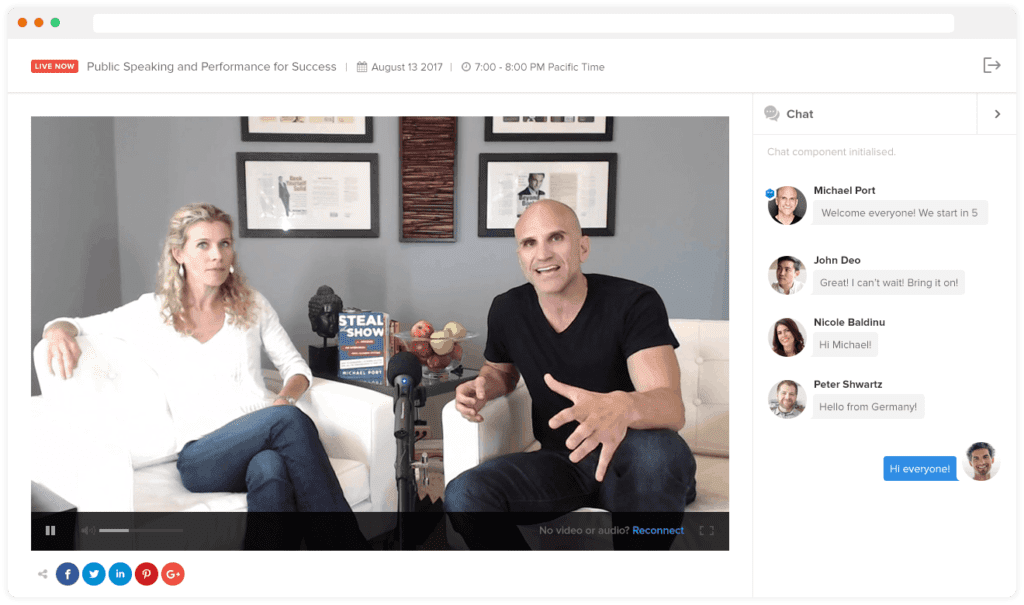
3. Mix in meaningful social
One of the typical criticisms of virtual events is that you don’t manage to get the same networking and interaction that you do with face-to-face events. While it’s true that face-to-face interaction has qualities that don’t translate directly to a virtual environment, the level and quality of interaction you can create online is really quite high – if you put some thought and effort into it.
We used Zoom as our Webinar platform for delivering live sessions. One of the many reasons we like Zoom is that, unlike GoToWebinar – which we had been using – it allows you to enable chat feature in addition to a Q&A feature during Webinars (GoToWebinar currently does not support chat during its Webinars). People are increasingly comfortable using chat as a tool and we had some really good exchanges during the sessions at our events. To help spark these exchanges, we made sure we were prepared to ask relevant, provocative questions during sessions and that we continually encouraged participants to contribute.
Note: Zoom has been (understandably) struggling to keep up with the demand for its service. If you are looking for an alternative to Zoom, you may want to take a look at WebinarNinja.
Chat during the live sessions is great, but we wanted to go further and provide a place were discussion could continue between and beyond sessions. There are a number of approaches for doing. We have seen events use private Facebook and LinkedIn groups successfully, for example. In our case, we decided to use the BuddyBoss because it has integrated discussion board and social networking features along with the great capabilities that WordPress offers as a content management system.
Keep in mind that social doesn’t just happen – at least not initially. You will need to remind people to participate in chat and discussion. I’ve already mentioned that we would continually prompt people to participate in chat during live sessions. For the discussion component, we sent out a weekly e-mail in which we highlighted some of the most active discussions on the forum and linked directly to them. The effort definitely paid off: we got hundreds of posts across dozens of topics.
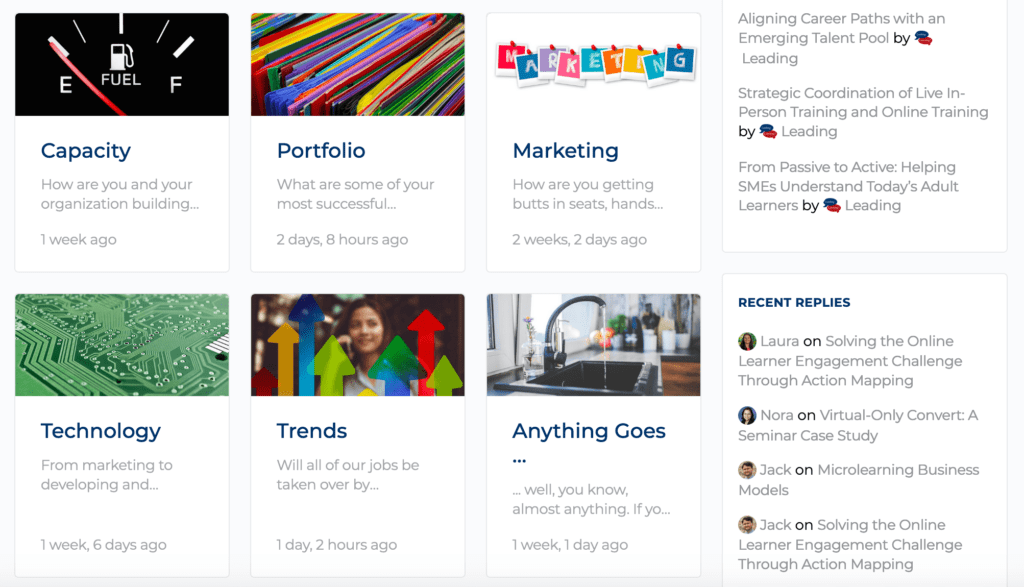
4. Use at least some live video
When I say “live video,” I mean actual human beings in real time on the screen. Not just slides and audio. Not just recorded presentations.
Thanks to platforms like Zoom, streaming video as part of a live Web event has gotten dramatically easier and less risky over the past several years and even just a small amount of video can make an online event feel much more personal and intimate – helping to boost attendee engagement.
We used video for a few minutes at the beginning of all of our sessions just to introduce the speakers – and then we turned it off once the speaker moved into the actual presentation.
We also used video for all of the priming and synthesis sessions mentioned above under “Add some context to your content.” (A still from one of our priming video sessions is included above.) The aim in both cases was simply to make it clear that, while the environment for the learning might be “virtual,” it was filled with real people – people who were there for real teaching, discussion, and learning.
5. Plan for strong customer support
Providing for clear, competent learner support is one of the main ways you can differentiate your event as a professional effort. And, if you want to position it as a premium offering, you definitely need to provide good support.
These days, people are much more accustomed to using the technologies that make a virtual event possible – e.g., Webinars, discussion boards – but that doesn’t mean you won’t run into technical headaches when you host a virtual conference. And, technology aside, you need to make sure that everyone understands all of the event logistics, including what sessions will take place when, where they go to access them, when they can expect recordings to be available. We made sure we posted navigation links to key information in obvious areas of the event Web site, but we also e-mail all attendees multiple times to make sure they knew the session schedule and how to access the sessions.
To help out anyone who did truly needed support, we had a support e-mail address and phone number in the footer of the Web site, a contact page with support information that was linked to as part of the main navigation and – again – we also let attendees know about their support options by e-mail.
Finally, we contracted through Upwork for someone to help us with support during as well as immediately before and after the live sessions. Really, you can find qualified people to do just about anything on Upwork – Fiverr is another great option – and the person we found was very professional and available at a very reasonable rate. We did not actually end up needing much support help – everything went very smoothly – but contract support was valuable to have as an insurance policy (not to mention a stress reducer!).
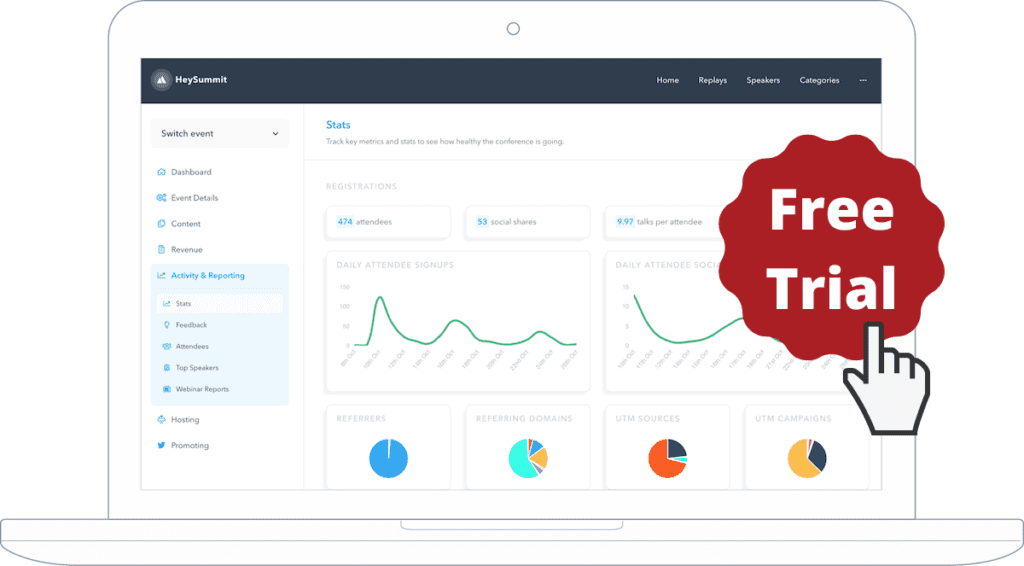
6. Prime your presenters for success
We lined up great leaders for each of our sessions, but we also knew that even the best presenters benefit from good support and opportunities for feedback and practice. So, we made sure from the very beginning – through e-mail and phone calls – that they had a good overall understanding of the event and also that they understood our expectations for their session. We also scheduled two calls with presenters during the weeks before the event.
One of these was what we call a “content call.” In this, we talked through the points the presenter (or, in some cases, presenters) planned to cover during the session and discussed ways we could help make each session as successful as possible. So, for example, we helped some presenters by identifying attendees willing to volunteer marketing or course materials for “diagnosis” during a live session. In another case, we actually collaborated with two presenters to deliver part of a session.
In general, the content call was a way to make sure the presenters had begun actively thinking about their material and that there was enough time for us to help fill any gaps or act on any good ideas that came up.
We also scheduled time for a “dry run” for each session. We did these a week or two before the scheduled time for the session and it gave the session leaders an opportunity to run through as much of their session as they wanted, both to get our feedback and also to make sure they were fully comfortable with the Zoom environment and didn’t run into any issues.
While I can’t say there were no glitches in the LTD sessions, I am certain that the time we spent helping presenters prepare greatly increased the overall quality of the event.
7. Treat attendees as collaborators
I mentioned above that attendees can be valuable collaborators for marketing the event. Through the use of social tools like chat and discussion, they also can and should be valuable contributors to the learning experience. But you can take things even a step or two further by featuring attendees in the session content. We did this in a number of ways.
One I have already mentioned is that we reached out to attendees to volunteer as case studies for some of the sessions. In one of the marketing sessions, an attendee provided a sales page from her organization’s Web site for analysis. For sessions focused on instructional design, one attendee sent in a screen shot from one of his organization’s Webinars, another sent in several screens from a self-paced course that she want advice on reworking.
In addition to leveraging materials submitted by attendees, we also offered “collaborative coaching” sessions. You can read about collaborative coaching process in more detail here, but the general idea is that an attendee poses a challenge or opportunity that she is facing in her learning business, and other attendees – most of whom have face similar challenges – provide advice. You need a certain amount of structure and process to make this work well – which we discuss in the post I just linked to – but the collaborative approach can result in some really great learning interactions.
Finally, we held weekly “Follow Up Friday” sessions which were essentially office hours for addressing questions and discussing any of the content covered in the event. In some of these, we invited attendees to become panelists in the discussion – that is, to join us on video. This brought some fresh faces and perspectives to the discussion
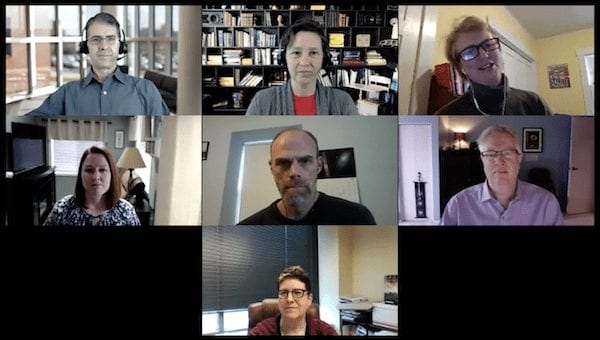
8. Leverage sponsors as partners
Depending on your business, working with vendors as sponsors may not be a part of your current business model. A virtual conference offers a great opportunity to expand into this area.
By “vendors” I mean companies that sell products or services that are of value to your target audience, but that don’t compete with whatever you provide. Ideally, whatever the vendor sells should complement your products or services. In our case, this meant primarily working with learning management system (LMS) vendors, as most of our attendees use or plan to use a learning management system.
Don’t worry if you don’t have a large audience. What most vendors want is a well qualified audience – that is a group of people who clearly possess the characteristics of the vendor’s target customers. If you can offer the chance to get in front of such a group, then you can greatly increase the efficiency of the vendor’s sales process – and that is valuable.
There are a number of ways to monetize this value, from recognizing sponsors (e.g., by displaying their logos) on a page of your event site, to mentioning an linking to them in your marketing e-mails, to giving them an opportunity to lead a session or otherwise speak to your audience during the event. These different approaches should, of course, come with different price tags – an opportunity to speak, for example, is much more valuable than a logo on a Web page.
Keep in mind, though, that revenue is only part of the value of sponsors.
Ideally, you want sponsors to promote the event to their audience, and you my want to incentivize them to do this buy offering some number of complimentary tickets as part of the sponsorship package. Sponsors can also be valuable in identifying, from among their customer base, attendees with relevant stories and case studies to share. And, sponsors may be willing to offer giveaways to some or all of your attendees – and approach that gains exposure for the sponsor and helps to attract attendees. Finally, a sponsor’s brand can be valuable in helping to bolster your own brand and the credibility of the event which, again, helps to attract attendees.
Of course, if you have never worked with sponsors before, getting started can seem a bit daunting. I may need to write a dedicated post on this topic at some point, but some key tips include:
- Determine the benefits you would be able to offer to a prospective sponsors and write these out clearly so that they can be shared with the prospect
- Research other events in your field or industry to see who has sponsored those events. While doing this, also look for any information you can find about typical rates for sponsorship.
- Identify one or more people at the target company who might make decisions about sponsorships. Usually, this is going to be someone in marketing and you can find these people through searching the companies Web site and/or by searching on LinkedIn.
- Ideally, find someone in your personal network with contacts at the target company and use this person as a way connect with whoever you have identified as a potential decision maker.
If you are not able to find a connection through your personal network, but can find a contact either through the Web, LinkedIn, or another source, go ahead and reach out directly. Just make it clear when you do that you have a solid understanding of the contact’s business and that you offer benefits that are highly relevant.
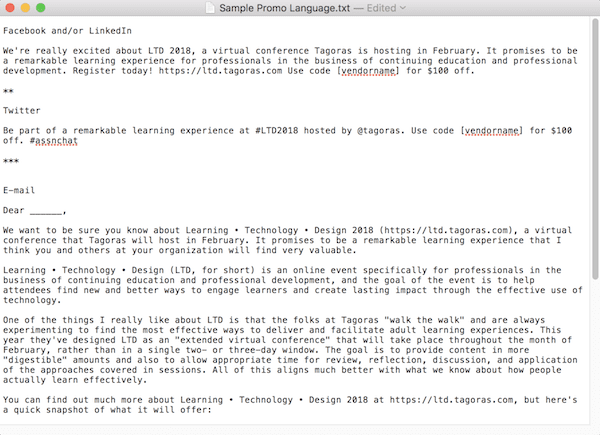
9. Take advantage of the medium
In many ways a virtual conference can and should mirror what happens at a face-to-face conference. By having elements like keynote presentations, breakouts, and opportunities for networking, you’ll align with learner expectations and increase the chances that they will take a chance on a virtual event.
That said, don’t overlook the opportunities that using a digital medium can provide when you host a virtual conference.
For example, we scheduled our most recent virtual event to take place over the course of a full month, with shorter sessions scheduled for an hour on Tuesdays, longer workshops and the above mentioned priming and synthesis sessions spanning four hours on Thursdays, and Follow-up Friday sessions – also mentioned above – taking place for an hour each Friday from 12:30 to 1:30 ET.
While this approach can be a somewhat harder sell for some prospective attendees, it also has strong advantages, including:
- By spacing out the learning over a longer period, there is a much greater chance that your attendees will have the opportunity to digest, review, reflect, and apply what they learn – particularly if you take steps to help facilitate these actions. The end result is that the event will have a much greater impact, greatly increases the chances that you will have satisfied customers who keep coming back for more.
- It gives you more time to actively engage with your learners in a meaningful way, helping you to build deeper, long-term relationships.
- It gives you some breathing room in planning, enables you to learn and adjust over the course of the event, and relieves some of the pressure for getting everything right in a single 1-3 day period.
- It can greatly increase the chances that attendees will make use of discussion boards. In the first place, they simply have more time. In the second place, they are almost certain to have more questions and comments related to the content as a result of the spacing effect suggested in bullet one above.
Each of these advantages is difficult, if not impossible to achieve with traditional face-to-face conferences. (And most of them align directly with supporting adult learning principles.)
Another key area where virtual conferences provide an advantage over face-to-face is in the ability to pre-record sessions. Overall, we have not made a lot of use of this capability, but we did run into the need to pre-record one of our sessions when the speaker had a last minute conflict. We were then able to play the recording during the scheduled time for the sessions and one of the speaker’s colleagues stepped in to help with handling real-time Q&A for the sessions.
We’re seen other virtual conferences make much more extensive use of pre-recorded sessions, usually with a similar approach to what I just described – they still play the sessions at a scheduled time, but then have real-time chat and Q&A to go along with it. This approach is very often just as effective as having the presenter deliver in real time, and it can give you a lot of control over session length and quality.

10. Don’t skimp on reminders
One of the big advantages of a face-to-face conference is that the attendees are essentially “captive.” Yes, they can skip out on sessions if they need to, but the fact that they are physically present greatly increases the chances that they will participate in most of the experience.
Obviously, this isn’t the case when you host a virtual conference. Even if people have paid to attend, “life” often interferes and participation in the event may take a back seat to demands from customers, co-workers, and other priorities. Moreover, the availability of session recordings – which most virtual conferences can and should offer – makes the “I’ll watch it later” excuse possible (and, of course, they rarely do watch it later).
While there is no way to get rid of this issue entirely, one of the most effective ways to combat it is to make sure you send out frequent reminders. This includes e-mail reminders of upcoming sessions, reminders to participate in discussion forums, reminders that recordings have been posted – basically anything that helps to keep the event top of minds and draw attendees back into the experience.
It is, of course, possible to over do it and annoy attendees with too much e-mail, but my recommendation would be to err on the side of annoyance.
Your attendees did, after all, sign up to attend and – particularly if they paid a registration fee – presumably want to benefit from the experience the event offers. I’d much rather have someone tell me that got a little annoyed by the amount of communication than tell me they missed out on parts of the experience because they forgot about it or didn’t know about parts of it.
Bonus Tip #11: Make Time for Everything Above
In my experience, virtual conferences are significantly less risky and time-intensive than many of the alternatives, but that doesn’t mean they are easy and that they don’t take time. If I were to add a tip to the list above it would be “Start well in advance!”
Everything I describe above is doable, even by a solo edupreneur or very small organization or company (we have a staff of 2.5 people), but it does take advance planning to get all of the pieces to line up. (We started about 4-5 months in advance.)
Still, if you are willing to do the planning and roll up your sleeves to tackle the areas I cover above, the chances you will host a virtual conference that knocks your attendees’ socks off are high.
Jeff
P.S. – See also:
- 11 Best Virtual Conference Platforms for Edupreneurs [2021]
- The Virtual Conference Business Model
- The Virtual Events Resources page at Leading Learning for more resources
- ReviewMyVCP – a site offering user reviews of virtual conference platforms
Table of Contents
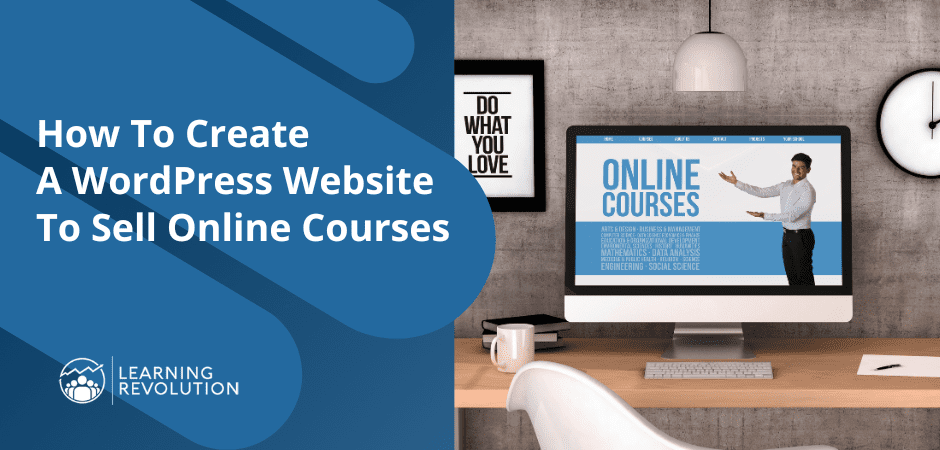
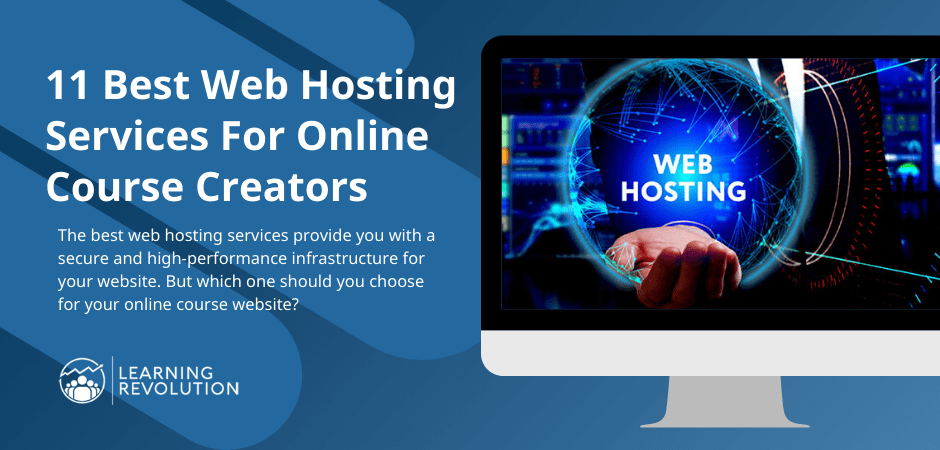
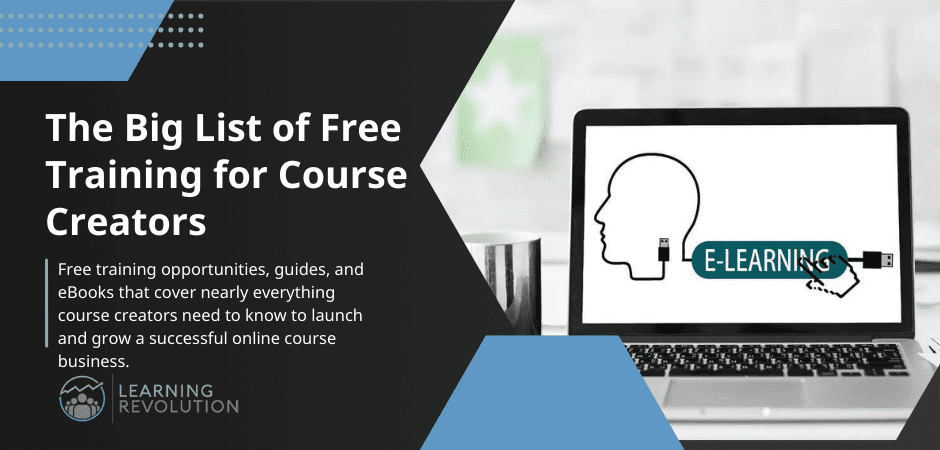
Virtual events are a fantastic way to get inspired, exchange ideas, and get the best resources, all from the comfort of your own home. During these unprecedented times, virtual events are more important than ever to keep the community united.
Cool tips, Jeff, thank you so much for sharing them. 🙏
We’ll definitely use some when organizing our online event, CommerceNow (https://www.2checkout.com/lp/commerce-now2020.html), this summer!
We currently use Zoom in combination with a WordPress site. Need to update it some, but most of our set-up is covered here (toward the end): https://www.learningrevolution.net/virtual-conference-business-model/
This is a really helpful article. Thank you! What online conferencing software do you use please? We already run a number of physical annual conferences with between 200-400 people at each. However, with the Coronavirus situation we are seriously considering turning these physical conferences into online, virtual conferences. Is there any particular online conferencing software you can recommend please? Thanks. Jeremy